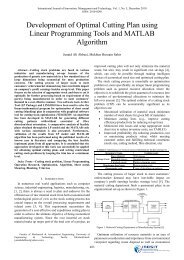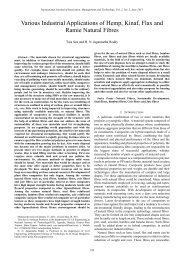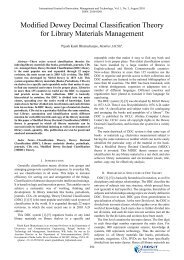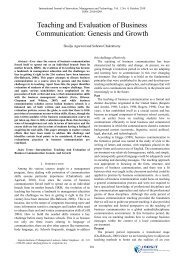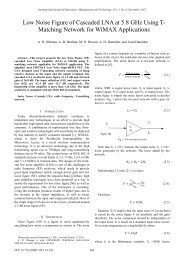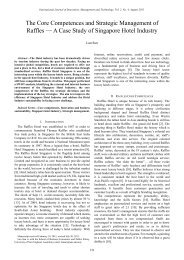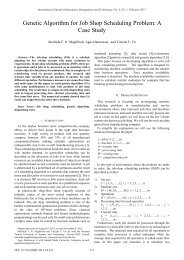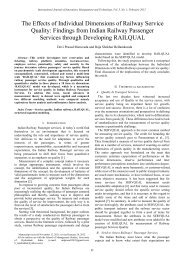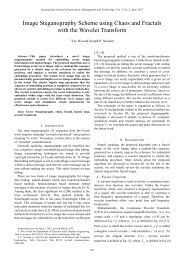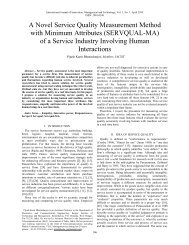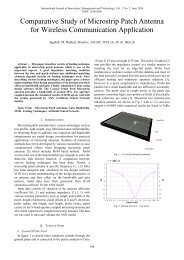The Barriers to SMEs' Implementation of Lean Production and ... - ijimt
The Barriers to SMEs' Implementation of Lean Production and ... - ijimt
The Barriers to SMEs' Implementation of Lean Production and ... - ijimt
You also want an ePaper? Increase the reach of your titles
YUMPU automatically turns print PDFs into web optimized ePapers that Google loves.
International Journal <strong>of</strong> Innovation, Management <strong>and</strong> Technology, Vol. 1, No. 2, June 2010ISSN: 2010-0248<strong>The</strong> picture <strong>of</strong> uneven diffusion across nations <strong>and</strong>industries <strong>and</strong> the evidence for the partial diffusion <strong>of</strong> leanproduction within firms <strong>and</strong> plants have led some scholars <strong>to</strong>dispute the real contents <strong>of</strong> the lean concept(Richard,2002)[7], questioning whether it is a coherent productionconcept (Bartezzaghi, 1999)[8].Many scholars have analyzed the reasons <strong>of</strong> successes<strong>and</strong> failures <strong>of</strong> implementation <strong>of</strong> lean manufacturing in ourcountry, many <strong>of</strong> them have pointed out that the result <strong>of</strong>implementation <strong>of</strong> lean manufacturing in our country is notsatisfac<strong>to</strong>ry mainly due <strong>to</strong> that China <strong>and</strong> Japan's nationalculture <strong>and</strong> corporate culture is very different. But we believethat national or corporate culture differences are not decisivefac<strong>to</strong>rs. As James P. Womack (2005)[9], the master <strong>of</strong>management, said that lean production can be applied <strong>to</strong> any<strong>of</strong> the different countries, regions, manufacturing plants <strong>and</strong>cultures.Since there is no direct relationship between the qualities<strong>of</strong> lean production’s implementation <strong>and</strong> culture, then what isthe key fac<strong>to</strong>r affecting the effective implementation <strong>of</strong> leanproduction. This paper believes that the problem lies in thatenterprises’ managers in China do not know the real meaning<strong>of</strong> lean production. Many enterprises <strong>of</strong>ten show <strong>of</strong>f theirmeans <strong>of</strong> production, such as the U-shaped production unit,Kaizen, Kanban, 5S, etc. It seems that lean production will beachieved as long as the application <strong>of</strong> these means <strong>and</strong> <strong>to</strong>olsin their enterprises. James P. Womack has given aconnotation <strong>of</strong> lean production in the ‘<strong>Lean</strong> thinking’ that itmeans continuing methodical march from success <strong>to</strong> success<strong>and</strong> doing it the hard way by creating real <strong>and</strong> trulysustainable value for their cus<strong>to</strong>mers, their employees, <strong>and</strong>their owners.It is clear that the implementation <strong>of</strong> lean production isnot only <strong>to</strong> introduce management methods <strong>and</strong> managementtechniques, but also <strong>to</strong> introduce the completely differentmanagement ideas <strong>and</strong> systems. <strong>The</strong>refore, we believe that inorder <strong>to</strong> carry out a thorough reform, that is, the effectiveimplementation <strong>of</strong> lean production, enterprises would beprovided from the following four organizational point <strong>of</strong>view ,<strong>and</strong> they are the attention <strong>and</strong> involvement <strong>of</strong> seniormanagers, good communication platform, learningorganization <strong>and</strong> the establishment <strong>of</strong> performanceevaluation system.A. <strong>The</strong> attention <strong>and</strong> involvement <strong>of</strong> senior manager<strong>The</strong> implementation <strong>of</strong> lean production, as a majorbusiness change, is bound <strong>to</strong> face resistance from the twoaspects. On one h<strong>and</strong>, it is the resistance from the individualsin enterprises, such as poor personal habits, personalinsecurity, as well as thinking <strong>of</strong> some people. On the otherh<strong>and</strong>, it is the resistance from the organization. Teamworking method, staff participation, pull-type productionmethods which lean production requires inverse <strong>to</strong> theoriginal terms <strong>of</strong> system-<strong>to</strong>-business, management thinking<strong>and</strong> management methods.In order <strong>to</strong> eliminate such resistances, senior managersmust have a high-level awareness <strong>of</strong> changing inmanagement, <strong>and</strong> firmly push forward the reform. <strong>The</strong>refore,it is necessary <strong>to</strong> establish a leader team whose members havereputation, decision-making power, information, expertise<strong>and</strong> good interpersonal relationships <strong>to</strong> ensure a smoothchange. <strong>The</strong> enterprises failed are <strong>of</strong>ten underestimated bytheir resistances <strong>to</strong> reform.222According the survey <strong>of</strong> Henry Johnson, an Americanmanagement scientist, about 43% <strong>of</strong> respondents believe thatthe establishment <strong>of</strong> a strong leadership team is an importantreason <strong>of</strong> the success <strong>of</strong> reform in enterprise [10].B. Good communication platformGood communication platform involves “networks” <strong>and</strong>“internal” platform.Why has lean production not been spread widely <strong>to</strong> SMEscompanies? One explanation is that, compared <strong>to</strong> largercompanies, SMEs <strong>of</strong>ten lacks <strong>of</strong> resources <strong>and</strong> competence <strong>to</strong>develop <strong>and</strong> improve their production systems [11]. Anotherexplanation is the “knowledge paradox” where thecompanies lack information on <strong>Lean</strong> <strong>Production</strong> <strong>and</strong> otherimprovement methods. One way <strong>to</strong> meet this has been <strong>to</strong> startnetworks <strong>to</strong>gether with other companies in order <strong>to</strong> learn <strong>and</strong>practice lean principles <strong>and</strong> methods. Bititci et al., (2004)stress that in collaborative networks, it is important for theparticipants <strong>to</strong> see value enhancement, internal or external(wealth <strong>and</strong>/or satisfaction). This creates a need for some sor<strong>to</strong>f performance measurement in the network [12].On the other h<strong>and</strong>, implementing lean production needs aeffective internal communication platform. <strong>Lean</strong> productionrequires that all staffs participate in the enterprise reform, allstaffs’ thinking <strong>and</strong> action must be unified. But this is acontinuing long-term process.In this process, communication <strong>and</strong> exchange is the mostimportant <strong>and</strong> perhaps the only way. And training is the bestway <strong>of</strong> communication.<strong>The</strong> implementation <strong>of</strong> lean production requires a lot <strong>of</strong>training including the training <strong>of</strong> advanced managementideas (such as lean production, full self-management) <strong>and</strong>training advanced management <strong>to</strong>ols (such as 5S, Kanban,rationalization proposals, etc.).Staffs that have uneven level <strong>of</strong> knowledge will have thesame language in day-<strong>to</strong>-day learning <strong>and</strong> communication.C. Learning organizationAt home <strong>and</strong> abroad many manager realize that leanproduction is a set <strong>of</strong> simple management <strong>to</strong>ols <strong>and</strong> systems,<strong>and</strong> in fact is a complex project that Toyota has foundedthrough long-term organizational learning <strong>and</strong> continuousimprovement.<strong>The</strong>re is no way that a big change as implementing leanproduction could be done over a night. <strong>The</strong> implementationhas <strong>to</strong> be carefully planned, the underst<strong>and</strong>ing from the staffshas <strong>to</strong> grow <strong>and</strong> the <strong>to</strong>p manager has <strong>to</strong> carry the plan quitehard without losing the employees trust or motivation.In Toyota production system, all staffs are good atlearning <strong>and</strong> active thinking in the process <strong>of</strong> continuousimprovement, which are much more meaningful thanlearning itself. Further improvements can be achieved whenstaffs have the ability <strong>to</strong> think effectively in the process <strong>of</strong>improvement. And good at learning is the essential feature <strong>of</strong>learning organization.Learning organization emphasizes life-long learning,whole process <strong>of</strong> learning, <strong>to</strong>tal learning <strong>and</strong> team learning.In a learning organization, everyone must be involved inidentifying <strong>and</strong> solving problems, so that organizations cancontinually improve <strong>and</strong> enhance its capacity.<strong>The</strong>refore, in order <strong>to</strong> learn from lean production,learning-oriented organizations must be set up in Chineseenterprises; <strong>and</strong> improving the organization's learning



